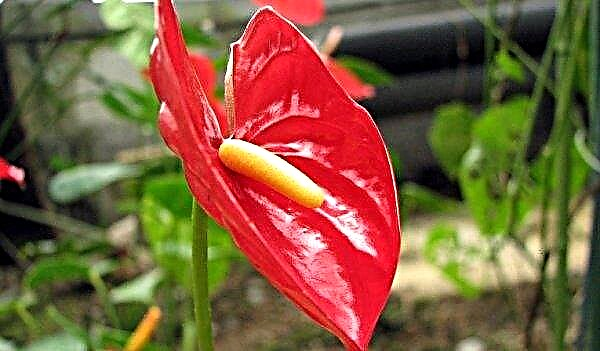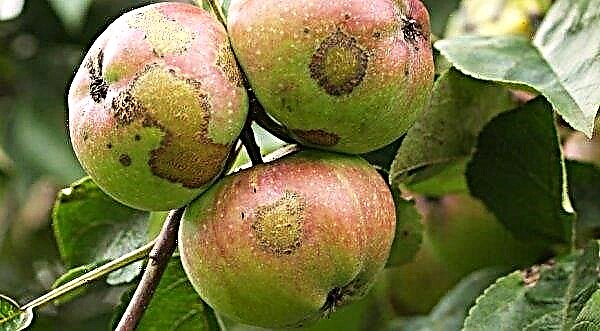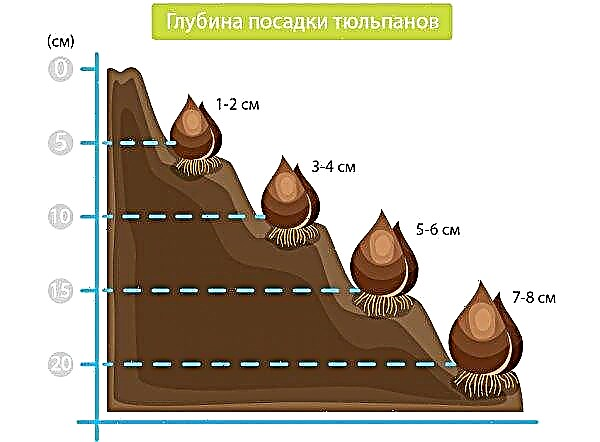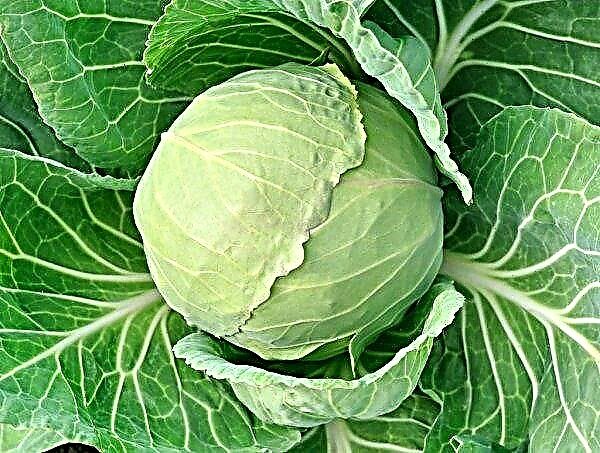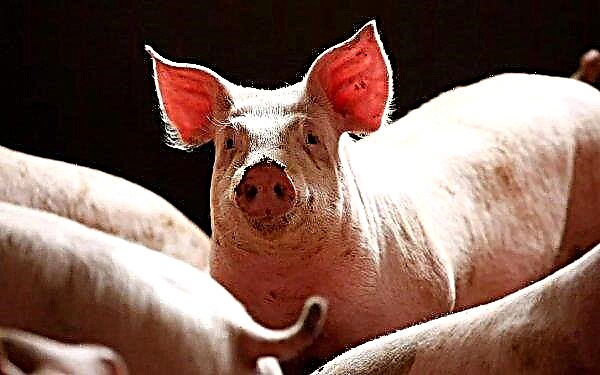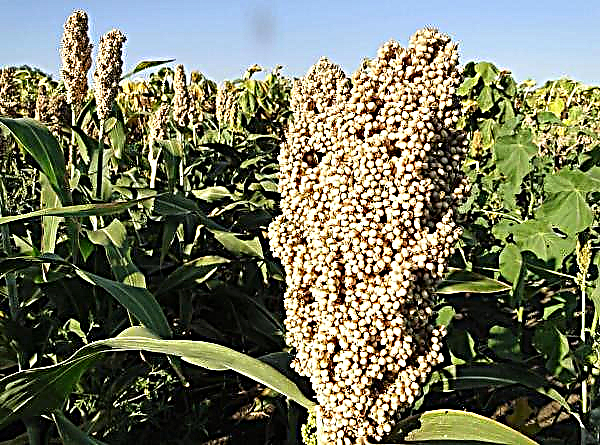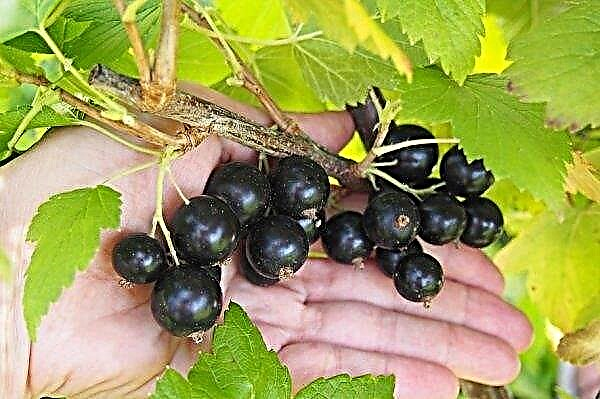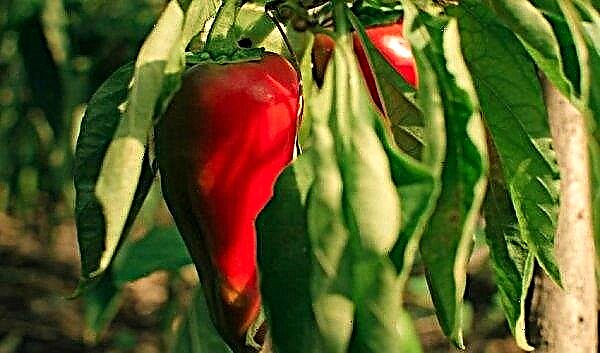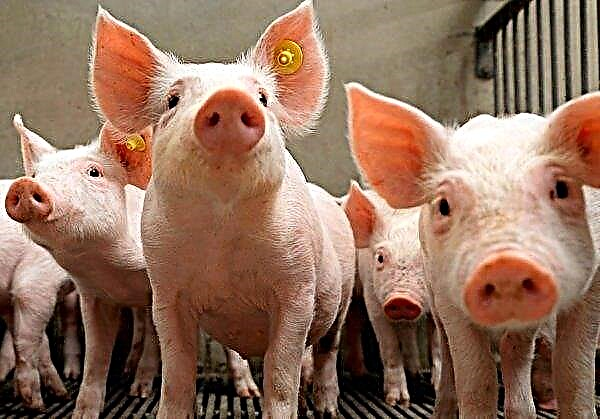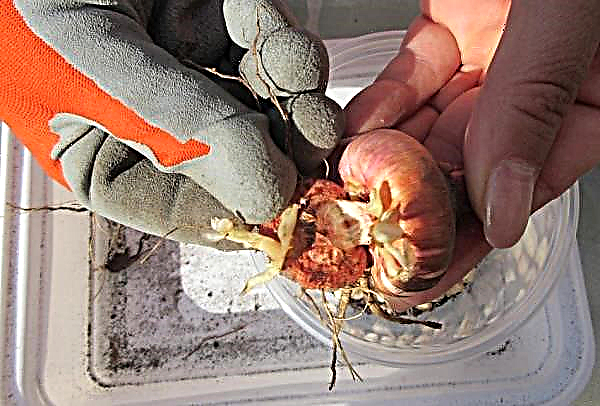An event such as vaccination requires knowledge, skill and perseverance. The article will help to organize and vaccinate the apple tree in the fall: we will consider how to perform this procedure and useful tips for beginners.
Why vaccination is needed
Vaccination is often used in horticulture as a vegetative way of propagating trees by combining several plants and setting them to their desired properties.
 Plant on a branch from 2 to 4 cuttings. In the future, leave the best (after 2-3 years)
Plant on a branch from 2 to 4 cuttings. In the future, leave the best (after 2-3 years)
There are several reasons and goals for vaccinations:
- not happy with the apple variety in the garden;
- no room for new trees;
- the apple tree is old, damaged by weather or rodents;
- fruit tree yield decreased;
- vaccinations can form the crown of the apple tree and its height;
- on the same tree you can harvest different grafted varieties, the main thing is that they coincide in ripening time;
- having planted a cultivar on a wild bird, you will receive noble fruits;
- it is possible to cultivate new varieties with increased winter hardiness, yield and resistance to harmful lesions.
You can change the situation and achieve the goal using the grafting method, but it should be remembered that the grafted variety is dominant and ensures the variety and appearance of the tree.
When can apple trees be planted in autumn
Autumn is not the best time for vaccinations.: Trees enter dormancy, discard foliage, and sap flow, which is very important for successful grafting, slows down. The onset of cold weather can ruin the scion and prevent it from taking root.
But some methods can be carried out in the fall:
- first half of September - budding, "for the bark";
- September October - copulation, splitting or half-splitting;
- at a later date work with young seedlings can be carried out at home or in greenhouse conditions.

Terms of work are selected depending on the region of cultivation and the time of the end of the vegetation of plants. In the south, vaccinations can be carried out in October or early November, and in the northern regions, in Siberia and the Urals, events must be completed by mid-September.
Autumn vaccination is more difficult than spring, and should be carried out in a short time.. It must be completed three weeks before the average daily temperature is + 15 ° С. Under such conditions, it is possible to achieve 95% survival of the scion. Checking the weather forecasts, you can decide on the feasibility of vaccination.
- Autumn works have such advantages:
- young apple trees grafted into the cleft tolerate planting and take root more quickly;
- can be corrected by re-grafting spring vaccination errors.
Tools and materials for grafting apple trees
For breeding processes, it is necessary to have a special set of tools, since not all kitchen knives and household appliances are suitable for grafting. For example, kitchen knives have a wide blade, and ordinary scissors pinch wood when cut.

Recommended vaccination kit:
- budding knife for the “eye” method with a rounded blade and a plastic part for peeling the bark on the opposite side;
- copy knife with a straight long blade;
- hatchet, mallet or mallet for work with rough branches and trunk;
- grafting secateurs (garden scissors) - its blades do not squeeze the wood and make cuts on the grafting components, which are fully combined (like puzzles);
- saw, hacksaw or delimbers;
- binding material - tapes made of polyethylene or polyvinyl chloride (2 × 25 cm), electrical tape, twine, self-destructing budding legs with staples, bast or raffia;
- wood products for putty (garden var, mastic, plasticine);
- tool sharpener;
- labels on a thread or wire with information about the grade and date of vaccination, which will mark the vaccinated places.
For successful vaccination, the tools must be debugged and sharpened sharply - so the slices grow together and heal faster.
Important! Before work and after each cut, the tool must be wiped with alcohol or calcined: fresh wounds on the plant can become foci of infection.
What can be used as a stock
As a stock for the apple tree, you can use:
- wild animals;
- seedlings of cultivars;
- medium and vigorous clonal stocks;
- two or three year old apple trees or mature trees.
In addition to related plants, you can use mountain ash, pome seeds (pear, quince), hawthorn, but non-native stocks are short-lived, do not provide the desired fruit quality and yield. For these reasons, it is better to work with them as an amateur breeding experiment.

The grafts, or grafts for vaccination, must be taken from annual shoots only in healthy, strong and abundantly bearing apple trees on the southern side of the crown.
Did you know? As people have blood incompatibilities, so apple trees have physiological tissue incompatibilities: for example, Antonovka, Papirovka, Cinnamon striped, but Melba are perfectly compatible with Kitaek varieties. And many varieties of apple trees do not grow well with the Siberian Siberian, which has small-cell wood.
Typically, the scion should satisfy the following requirements:
- minimum storage time (scion should be fresh);
- length - 20–35 cm:
- diameter - 1-2 cm;
- the number of kidneys is 3-5.

Vaccination Methods
There are more than 10 ways to vaccinate apple trees, but methods that can be carried out in the fall and which a novice breeder will cope with are:
- budding, or budding (from the word "eye", "eye");
- copulation (from the Latin "intergrowth");
- in a split (or half split);
- over the bark.
Ophthalmic Inoculation
The method is considered universal in terms and simple to execute.. This method is also known as budding, or eye vaccination. For the work you will not need many cuttings, you need to harvest them immediately before the procedure.
Sap flow slows in the fall, so a few weeks before the event, you need to abundantly water the tree on which the stalk will be grafted. This will improve the elasticity of the cortex and it will be easily detachable.
 Engage in dodging in late August and early September
Engage in dodging in late August and early September
Work sequence:
- The choice of location is 8 cm above the ground for seed and 15 cm for clonal stock. Eliminate sharp bends and select a location below the bend of the trunk or branch. The bark should not have damage, knots and growths, if necessary, clean.
- With a sharp knife, cut the bark with a T-shaped incision, being careful not to damage the wood - first a transverse incision (should be 1.5–2 cm), and then from bottom to top longitudinal to the middle of the transverse (3-4 cm). The bark is carefully pushed along the transverse incision.
- Kidney-eyes on the scion should be "sleeping", that is, appearing in the summer on annual growths, but not growing.
- Cut the shield from the cuttings (dimensions 4 × 2 cm), capturing part of the wood - the cut should be smooth and without chipping.
- Insert the shield into the cleavage of the cortex, placing the kidney up and exactly in the middle, connecting the layers of cambium.
- Press the bark to the trunk and fix with the strapping ribbons, turns from top to bottom, leaving the kidney outside the winding.
- After a couple of weeks, check the result and, if vaccinated successfully, loosen the harness.
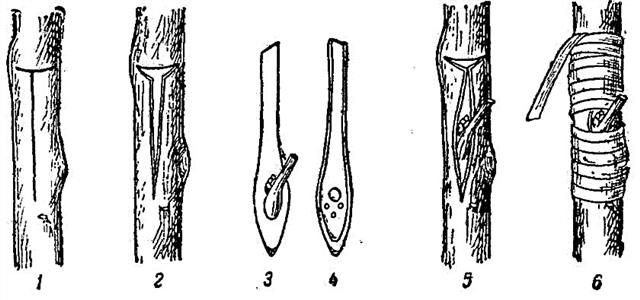 Casing: 1 - T-shaped incision on the stock; 2 - raised crust at the section; 3 — a shield cut off from the handle; 4 - the reverse side of the flap; 5 - the shield is inserted into a T-shaped section; 6 - eyelet budding
Casing: 1 - T-shaped incision on the stock; 2 - raised crust at the section; 3 — a shield cut off from the handle; 4 - the reverse side of the flap; 5 - the shield is inserted into a T-shaped section; 6 - eyelet budding
If the cortex is poorly separated, then budding is done. With this method, a shield is cut out on a stock and replaced by the same size scion shield with an “eye”. The rest of the technology will be the same.
Cowling can be done not with one but several kidneys, placing them on different sides of the trunk and tying at the same time. The grafted “eyes” on one branch should be located at a distance of at least 20 cm from each other, and the lower one at a distance of 30 cm from the fork.
Important! The upper part of the shield should be shorter than the bottom, since it is from the bottom that the plant juices, moisture and nutrients come in, which contributes to the rapid fusion.
Copulation
This method is used with the same thickness of the grafted components - not more than 2.5 cm in diameter. The stock can be slightly larger than the stock, but not vice versa. These requirements are met one or two year old seedlings. Most often, the method is used for grafting the game variety varieties of apple trees.
There are two ways to copy:
- Simple - oblique sections on the spliced components are even and straight. The disadvantage is the instability of the combination.
- Improved - Zigzag sections for a high-quality and reliable connection.

Slices are convenient to do with grafting secateurs. A set of knives allows you to make cuts on the stock and scion, perfectly matching each other. This provides a good grip without additional adjustment and a strong connection of instances in one branch. It is necessary to control that there are no gaps, displacements, and the fabrics of the cambium layers coincide. Slices are tied and processed with putty for better intergrowth of the components.
The method can be used at any time of the year, even in winter at home or in greenhouse conditions.. It is not so easy to vaccinate without experience, so it makes sense to practice on any branches.
Did you know? The apple tree is a wonderful neighbor: many fruit crops (pears, cherries, plums) feel good next to it. But she herself does not tolerate the neighborhood of cherries, lilacs and viburnum.
Split vaccine
The method is used with a large difference in thickness between grafted components and allows you to rejuvenate or increase the crown of the apple tree, to plant several varieties on one old tree. As a stock, 3–6 year old boles and skeletal branches up to 8 cm thick are suitable. For autumn grafting, the time until the end of the growing season when the sap flow is still active, that is, the beginning of autumn, is chosen for engraftment of the grafted material.
 Vaccinations in the split and half split are often used in the fall when re-grafting 2-4 centimeter branches
Vaccinations in the split and half split are often used in the fall when re-grafting 2-4 centimeter branches
Recommendations and sequence of work:
- Saw off the trunk - 20 cm from the ground, or a branch - 20 cm from the trunk.
- Split completely to a depth of 5–8 cm. Adjust the depth of the crack depending on the diameter of the cuttings.
- To prevent the gap from closing, insert a handy tool (screwdriver, peg, hatchet).
- Use a scion with 4-5 sleeping kidneys.
- Use a sharp knife to cut a 5 cm section at the end of the scion below the second kidney with a wedge.
- Insert the stalk with a wedge into the crack, connecting the cambium tissue. The wedge should fully enter and not be higher than the end.
- Tie tightly with tape material, you can use small nails for fixing, but be careful with the scion.
- Coat the end section, side cracks, the graft site and the top section of the scion with garden putty (it should be transparent).
Important! For better adhesion and reduction of voids, first fill the crack with the handle with softened plasticine, then wrap it with a twine.
If the thickness of the rootstock allows several cuttings to be grafted into the cleavage and several further growths can be obtained: for example, make two splits in the rootstock stump on the edges, and in a half-split circle every 5–8 cm. This method makes it possible in the future to obtain an apple tree with a vase-like crown.
Vaccination for bark
Vaccination for the bark will help rejuvenate and give new life to the old tree. It can be carried out both on a separate branch, and on a small hemp. The bark should be elastic and flexible, well separated from the trunk wood, not crumble and not peel off.
Recommendations and sequence of work:

- Prepare an annual high-grade graft up to 35 cm long with 2–4 sleeping “eyes”.
- Saw off the grafting branch or trunk, leaving 0.5–0.7 m.
- Strip the butt with a knife, and wipe the branch and trunk at the site with a soft rag from dust and dirt and tear off the foliage.
- At the end of the rootstock along the bark, make a longitudinal cut (5-6 cm), being careful not to touch the wood, but to open only the meadow and cabium layer, with a blunt knife or the plastic part of the budding knife, peel the bark from the trunk.
- On the scion under the “eye”, make an oblique cut of 3 cm and place it in the incision of the bark with a sharp cut to the trunk. The cut edge of the cut should be 3-4 mm higher than the cut.
- If a cut of the cut is made with a shoulder, then the shoulders lie exactly on the end of the saw.
- Press the bark to the trunk and secure with a strapping material or twine.
- Coat the vaccine with garden varieties, plasticine, or other suitable means to prevent drying.
If the size of the trunk allows, you can plant several cuttings, and after 2-3 years, leave the strongest of the surviving.
Important! The age of the vaccinated component should not be older than 4 years.
How to plant an apple tree
The following tips will come in handy for gardeners who want to get vaccinated and successfully complete these activities:
- The cambium layers of the cells of the grafted components should coincide and be tightly pressed - it is in this layer that sap flow occurs.
- Do not use spinning tops (fruitful buds are poorly developed on them), continuation of conductors and central branches (so as not to spoil the shape of the crown).
- Pick cuttings only from healthy and strong branches.
- Do not get vaccinated on the south side of the apple tree in rainy weather or under the scorching sun.
- The best "eyes" are in the middle part of the growth.
- Do not use film cover, which can cause a greenhouse effect and rotting of the scion.
- Minimally reduce the time between scion harvesting and grafting - only a fresh cut grows well.
- Tools, hands and the place of vaccination should be clean.
- Insulating tape as a binding material is applied with the sticky side out.
- The time of engraftment of the scion is 2-3 weeks.
Video: Vaccination of the apple tree
How to care for grafted apple trees
Even correctly and on time, the work done will not bring positive results, if you do not take care of the grafted apple tree in the future:
- after 2 weeks, check the vaccination site and loosen the winding, in the spring it can be completely removed;
- birds and snow cover can break off young scion, so provide protection and insulate it with covering material for the winter;
- if the operation is unsuccessful, the graft does not take root or rot. In this case, remove it, and disinfect the wounds on the wood and treat with wood putties;
- regularly cut off the shoots below the vaccination site with secateurs to ensure proper nutrition;
- tie the growing shoots, since at first the mechanical connection of the grafted components is still weak;
- during the preparation of apple trees for winter, water the trees abundantly.

